58th General Hospital Unit History
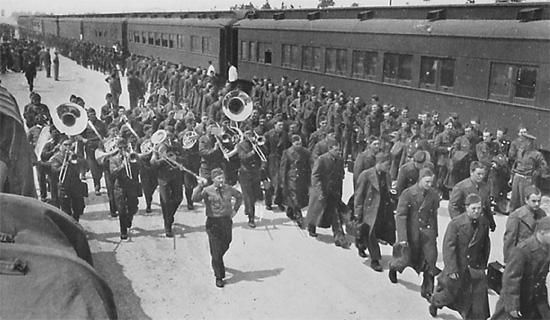
Photograph taken in 1940. New recruits arrive at Camp Livingston, Alexandria, Louisiana by train; they are welcomed by a band before being marched off to the Post Reception Center.
Introduction:
On 25 November 1940, permission was granted by the Secretary of War for the formation of a General Hospital unit sponsored by the Western Pennsylvania Hospital, Pittsburgh, Pennsylvania, which would be officially known as US Army General Hospital Unit No. 58. Dr. Frank R. Bailey, MC, O-410134, with the rank of Lt. Colonel, was appointed Unit Director and Chief of the Surgical Division (he became acting CO and was responsible for administrating and handling all communications toward the formation of the new hospital unit –ed), and in April 1941, the organization of the medical personnel was completed, 34 of whom were members of the active staff of West Penn Hospital or former interns. The members were chosen in such way that no service of the hospital was depleted, and the remaining members of each service could carry on their customary duties in the hospital.
The Western Pennsylvania Hospital was also to sponsor the US Navy Naval Mobile Hospital Unit No. 5, organized by Commander Lyndon H. Landon, whose personnel were almost wholly drawn from the Hospital and eventually served in the Far East.
Activation & Organization:

Article published in the Sun-Telegraph November 1942, announcing the activation of the 58th General Hospital at Camp Livingston, Alexandria, Louisiana. Photograph illustrating First Lieutenant Agnes M. Patterson, ANC, N-743661, and Lt. Colonel Frank R. Bailey, MC, O-410134, Commanding Officer, United States Army Base Hospital Unit No. 58, which was to go into active service early in the new year. Both Officers were presented with an American flag at services held in the auditorium of the West Penn Nurses’ Home. Lieutenant A. Patterson was to lead the 105 Nurses of the 58th General Hospital.
It must be noted that the new hospital was in fact the offspring of the 207th General Hospital (activated 10 Feb 41, which supplied cadres for both the 30th Gen Hosp and the 58th Gen Hosp –ed), the parent unit, formed for training of General Hospitals, and which supplied Enlisted personnel cadres for affiliated units that were marked for embarkation for service overseas. Early in December 1942 a directive issued by the Surgeon General’s Office was received (with a notice indicating that the unit would be called to active duty) asking that 10 Officers be sent at once to Camp Livingston, to supplement the initial cadre of the 207th Gen Hosp for their own training and to assist furthermore with the training of Enlisted Men. The first Officers who preceded the 58th enroute to service were: Major George E. Bair, MC, O-173875 – Major Thomas G. Ferguson, MC, O-410363 – Major William A. Heazlett, MC, O-251836 – Captain Eugene M. Hagan, MC, O-356586 – Captain William L. Hauk, MC, O-409826 – Captain Andrew J. McAdams, MC, O-327611 – Captain Charles C. Murphy, MC, O-410356 and First Lieutenant Thomas E. Purpura, MC, O-436218. All the above passed their physicals at Carlisle and were ordered to go on active duty, starting 2 January. Major James B. Hall, MC, O-438407 and First Lieutenant Harry A. Black, Sr., MC, O-368806, already in service, joined the above named Officers 12 January 1943 (these Officers, after transferring to the new unit, aided in its organization –ed). The selected Officers left Pittsburgh and arrived at Camp Livingston, Louisiana, 14 January where they were immediately assigned to the active 207th General Hospital. Some of the professional Officers received a basic military training at Carlisle Barracks before eventually reporting to the new 58th General Hospital for duty. Two Chaplains were assigned to the group; Captain Richard D. Johnson, ChC, O-487819 (Presbyterian Church) and Reverend James D. Campbell, ChC (Roman Catholic Church). The Nurses received their basic military training at various Military Hospitals in the Zone of Interior, while a number of Technicians recruited from the Hospital and nearby areas received a preliminary training at Camp Lee, Petersburg, Virginia (Army Service Forces Replacement Training Center, total acreage 7,534, troop capacity 2,143 Officers and 38,427 EM –ed). The EM to be attached to the new unit were supplied by the US Army and were also in training. A number of them belonging to the 1303d SU at Camp Lee were ordered to join the 207th General Hospital on a temporary assignment pending activation of the 58th General Hospital. Fourteen (14) EM who joined the Enlisted Reserve Corps were already ordered to active duty and subsequent training on 9 December 1942. They included; Private Charles D. Bossart, Sergeant Harry J. Bubenheim, Private Niels Christensen, Technician 4th Grade William D. Coombs, Staff Sergeant Osiride A. DiSilvio, Technical Sergeant Sylvan E. Ehman, Technician 4th Grade William F. Gavin, Private George M. Kelly, Private Frank J. Lynn, Technician 4th Grade Edward Mauerberger, Technician 5th Grade John C. Michels, Technician 3d Grade Joseph Miko, Staff Sergeant George W. Orth, and Technician 5th Grade Robert D. Short.
First Lieutenant Agnes M. Patterson, ANC, N-743661, was put in charge of the Nursing Division, and became responsible for 105 Nurses. The roster was completed many months prior to the unit’s organization, and this allowed for about 70-75% of the Nurses to participate in active training in anticipation of transfer to the new unit when activation was to be completed.
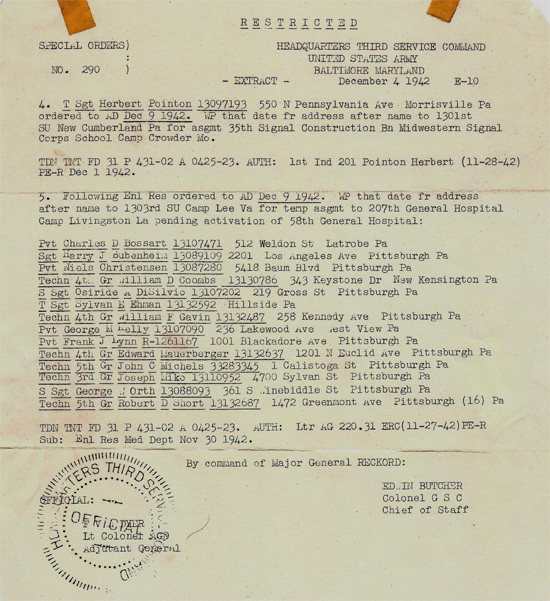
Extract of Special Orders No. 290, issued by Headquarters Third Service Command, United States Army, Baltimore, Maryland, dated December 4, 1942, ordering a number of Enlisted Reserve Corps personnel to be temporarily assigned to the 207th General Hospital, pending activation of the new 58th General Hospital.
Organization of the 58th General Hospital took place at Camp Livingston, Alexandria, Louisiana (Army Ground Forces Training Station, total acreage 47,967, troop capacity 2,092 Officers and 42,831 EM –ed), effective 15 January 1943. The new organization was ordered into active service of the United States pursuant to General Orders No. 110, Headquarters Third Service Command, dated 22 December 1942, and General Orders No. 126, Headquarters Eighth Service Command, dated 24 December 1942, and organized in accordance with instructions contained in War Department Letter AG. 320.2 (12-14-42) OB-I-SDP-M, dated 18 December 1942, Subject: Ordering into Active Service, Organization and Inactivation of certain General Hospitals.
The organization was to be established in accordance with T/O 8-550, dated 1 April 1942, with an authorized strength of 56 Officers – 1 Warrant Officer – 105 Nurses – and 500 Enlisted Men. Grades were authorized as per the Table of Organization.
On 15 January 1943, the Enlisted Men and ANC personnel and equipment of the 207th General Hospital were transferred without loss of grades to the 58th General Hospital and concurrently the 207th was to be inactivated. The Medical Department Officers of the 207th Gen Hosp were to be re-assigned as far as ranks and qualifications permitted, to vacancies in the 58th. Any remaining Officers were to be re-assigned by the Surgeon General’s Office. Headquarters, 58th General Hospital, was officially opened at Camp Livingston, Louisiana, at 0001, 15 January 1943, and effectively activated in compliance with the previously mentioned General Orders and the more recent General Orders No. 5, Headquarters Camp Livingston, Louisiana, dated 13 January 1943. The Commanding Officer became Lt. Colonel Harold B. Luscombe, MC, O-18298, assisted by Major Alvin J. Swingle, MC, O-449910, Executive Officer, and First Lieutenant Winslow A. Rose, MAC, Adjutant.
Elimination of unfit or unqualified personnel was carried out by CDD and Section 8 Regulations, and new Medical Officers, who were not of use in the organization, were directly assigned to the Post’s Station Hospital for training in their respective new positions, beginning 20 January. Some additional Officers from other branches joined on 27 January 1943. The latter included Second Lieutenant Michael H. Cruise, QMC, Second Lieutenant Ernest M. Orrestein, QMC, and Warrant Officer Junior Grade, Peter C. Adamkiewicz, USA. On 1 April 1943, the following Officers joined; Lt. Colonel Frank R. Bailey, MC, O-410134, who became Chief of Surgical Service, Lt. Colonel James M. Strang, MC, O-409137, who was appointed Chief of Medical Service; and Major Hyman A. Slesinger, MC, O-225896, who became responsible for the Laboratory Service.
The new unit was assigned to the area formerly occupied by its parent unit; Enlisted Men were quartered in hutments that permitted the comfortable billeting of 5 men; the Officers were individually put up in small hutments. All living quarters were gas heated. At the date of activation, the 58th Gen Hosp consisted of 13 MC Officers – 4 MAC Officers – 2 QMC Officers – and approximately 200 Enlisted Men. All medical installations at the Post were under the supervision of the CO, Station Hospital, Camp Livingston, for training purposes.
From 15 January 1943 until 3 December 1943, the 58th was engaged in activities which were necessary to prepare it to perform its mission. The organization was established in accordance with provisions AR 40-590 and Tables of Organization 8-550.
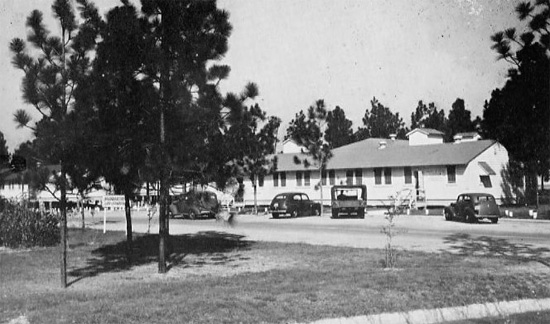
Partial view of Camp Livingston, Alexandria, Louisiana, Post Headquarters buildings.
Training:
The training of personnel was conducted as per the requirements of MTP 8-1 and MTP 8-10. As indicated in the previous paragraphs, a number of Officers had already received preliminary training, others went through basic military training while staying at Carlisle Barracks before reporting for duty to the 58th. Weekly training schedules based upon these MTPs were submitted to the CO, Post Station Hospital, for approval. During the sessions, the unit Commanding Officer made frequent inspections to be certain that training was properly conducted and held conferences with instructors to correct any deficiencies. Examinations and tests were held on a regular basis to determine the state of the training. It should be noted that training facilities were quite limited as the only adequate classroom available was the recreation hall serving several units (schedules had to be arranged among the units concerned). Fortunately, it was possible to hold outdoor classes among the trees in the area; a ward tent was set up to serve as an emergency class in case of inclement weather. On the other hand a lack of personnel affected the training schedules, as many personnel were often absent for short periods, having to attend other duties. This did not allow for frequent rotation of duty posts at the Post Station Hospital, which later even caused problems in obtaining the release of 58th Gen Hosp personnel for the purpose of POM.

Layout of Camp Lee, Petersburg, Virginia where a number of personnel joined the 1303d Service Unit for temporary assignment to the 207th General Hospital and other Technicians followed some training in January of 1943.
The value of training aids was fully recognized; a well-managed film library was used; charts were improvised; and every effort made to achieve the maximum realism since medical subjects were entirely foreign to most of the trainees! Moulages were therefore used to realistically depict battle injuries. The value of this type of realistic training was demonstrated by the reaction of the students. Some turned pale, others nauseated, and even a few fainted during the presentations. Simulated injuries were treated both as aid station emergencies and as hospitalized patients by the trainees.
Equipment, transportation, and supplies at the Post were entirely adequate. Laundry was taken care of by the Post Quartermaster. The new organization did not participate in any Army maneuvers, but tactical marches and bivouacs of several days were conducted regularly. Protection and camouflage against ground, air, and gas attack were practiced; smoke pots, snipers, strafing by airplanes were introduced at unannounced intervals during field exercises. The infiltration course had to be taken by everyone before departure for overseas.
Prior to movement of the unit, a complete medical and detailed survey was made of each individual member, and corrective measures were instituted where possible.

Photos illustrating Training of Enlisted personnel at Camp Lee, Virginia. Left: standing in front of one of the tents; Private Niels Christensen (13087280), Sergeant Harry J. Bubenheim (13089109), and Technician 4th Grade William D. Coombs (13130786). Right: sitting around a pot-bellied stove; Technician 3d Grade Joseph Miko (13110952), Staff Sergeant Osiride A. DiSilvio (13107202), and Technician 4th Grade William D. Coombs (13130786).
28 April 1943 became an important day for the hospital unit as “The Mercury” – weekly publication of the 58th General Hospital – was published for the first time at Camp Livingston, Louisiana.
While staying at Camp Livingston an Enlisted Men’s music band was organized. The Braddock American Legion gave the unit some drums and West Penn sent the necessary funds to buy more instruments. The band was organized and headed by Technician 5th Grade Mike Mazulla who got the boys together and the band going. When orders came in to move (at first it was thought that the Mediterranean Theater was the unit’s destination –ed), the organization packed up the band instruments, against regulations of course, and shipped them along too. When orders were eventually changed to Fort Devens in the ZI, that was the end of the band; the instruments were never seen again!
Following Special Orders No. 28, dated 24 June 1943, and under the provisions of AR 615-5 as amended by Paragraph 1, Section IV, War Department Circular No. 148, dated 18 May 1942, and upon the recommendation of the CO, a number of promotions and changes in grade took place, effective 1 July 1943, within the 58th General Hospital. The promotions involved 53 Enlisted Men. First Lieutenant John H. Burrows, MAC, O-508884, was appointed Registrar (relieving Second Lieutenant Harold E. Laak, MAC, O-1542521).

While in Training, extensive presentation and instruction of a GI’s standard field equipment was given, highlighting such items as; Haversack, Pistol Belt, Gas Mask and Carrier, Pouch, First Aid Packet, Dismounted Canteen and Cup, Dismounted Leggings, Canvas, and Shoes, Service (no weapons are illustrated).
Early July 1943, 29 ANC Officers were recruited among Nurses serving at Fort Eustis, Lee Hall, Virginia (Antiaircraft Artillery Replacement Training Center, total acreage 8,098, troop capacity 815 Officers and 17,266 EM –ed). Upon arrival the ANC personnel was distributed over different Army Camps for TD going to Camp Pickett, Blackstone, Virginia; to Fort Eustis, Lee Hall, Virginia; to Camp Lee, Petersburg, Virginia; to Camp Patrick Henry, Oriana, Virginia; and to Walter Reed General Hospital, Washington DC. They were to return to Camp Livingston where they would be joined by Nurses from other camps to form a 100-Nurse complement to accompany the 58th General Hospital overseas. Having gone through nursing before, no such duties were assigned the Nurses during their short stay at Camp Livingston; they however were issued combat gear including field jackets, heavy-duty shoes, leggings, gas masks, and helmets. New clothing followed, including HBT fatigues, and the necessary paraphernalia for overseas duty. They further underwent inoculations, endured medical and dental examinations, had blood tests taken, followed lectures, received their dog tags and were fingerprinted for the new GC-protected personnel identification cards. It should be underlined that while at Camp Livingston, the Nurses went on many hikes, participated in bivouacs, and followed close order drill. In fact training was almost as harsh as the men’s, including the infiltration course and the gas mask tests.
Preparation for Overseas Movement:
The 58th General Hospital was alerted for movement on 15 July 1943. Processing was promptly completed and the unit entrained at Camp Livingston, Louisiana, on 11 August, arriving at Camp Shanks, Orangeburg, New York, 14 August 1943 (Staging area for New York Port of Embarkation, total acreage 2,009, troop capacity 2,545 Officers and 46,367 EM –ed). The three-day travel was accomplished by day coaches, not very convenient but it served as a reminder that unpredictable hardships could always be expected.
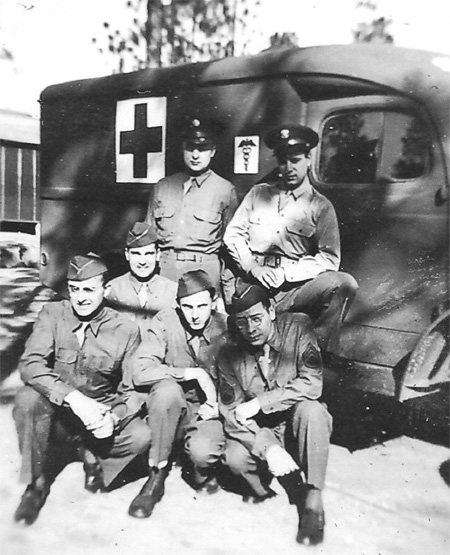
Zone of Interior 1943. Photo illustrating Enlisted personnel of the 58th General Hospital in front of one of the unit’s WC-54 3/4-Ton Ambulances, while in Training at Camp Lee, Virginia.
At Camp Shanks the required processing in preparation for overseas movement (POM –ed) was completed in the shortest possible time. A new training program was introduced under supervision of the local Camp Commander and training schedules for Nurses, male Officers, and Enlisted Men were established. Hikes, closed order drills, gas mask tests, censorship regulations, medical examinations, etc. followed each other. After completing processing, orders were suddenly received to proceed to Fort Devens, Ayer, Massachusetts (Military Reservation, total acreage 11,796, troop capacity 2,066 Officers and 33,232 EM –ed). This trip took place by rail on 26 August 1943 (it seems that one of the reasons to postpone departure was that it wasn’t safe to cross the Atlantic because of the many German U-boats patroling its shipping lanes –ed).
At Fort Devens, Massachusetts, the 58th General was quartered in wooden barracks previously occupied by the Women’s Army Auxiliary Corps (WAAC –ed). An advanced training program was instituted under the supervision of the local CO. Training inspections followed by Officers from the First Service Command. Individual oral and practical tests and exams were held during the course of several days, with personnel being examined in basic, technical, and tactical subjects, ending with a general rating of “excellent”.
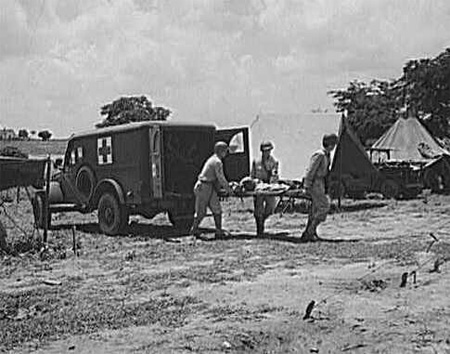
Zone of Interior 1943. Photos illustrating Evacuation Training of Enlisted personnel with a WC-54 Ambulance vehicle at Camp Lee, Virginia.
On 30 September 1943 the organization left Fort Devens and moved to Camp Kilmer, Stelton, New Jersey (another Staging Area for New York Port of Embarkation, total acreage 1,815, troop capacity 2,074 Officers and 35,386 EM –ed) where it arrived on 1 October 1943. A further stage in POM was promptly completed with everyone guessing this was the final one prior to actually moving overseas. Dental Officers worked for long hours, day and night, to correct any dental deficiencies in personnel of the various units staging at the Camp prior to their departure.
1943 Officers Strength – 58th General Hospital
18 October 1943 > 37 MC – 5 DC – 8 MAC – 2 SnC – 1 WO – 1 PT – 2 HD – 100 ANC – 2 QMC – 2 ChC
31 October 1943 > 37 MC – 5 DC – 8 MAC – 2 SnC – 1 WO – 1 PT – 2 HD – 100 ANC – 2 QMC – 2 ChC
30 November 1943 > 37 MC – 5 DC – 8 MAC – 2 SnC – 1 WO – 1 PT – 2 HD – 100 ANC – 2 QMC – 2 ChC
31 December 1943 > 36 MC – 5 DC – 8 MAC – 2 SnC – 1 WO – 1 PT – 2 HD – 100 ANC – 2 QMC – 2 ChC
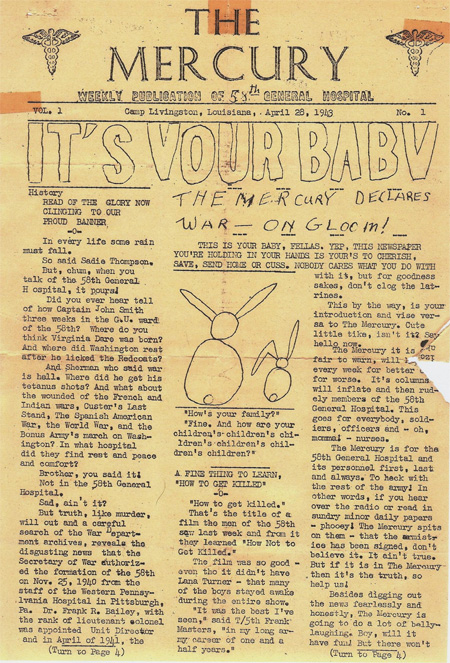
Photo illustrating the unit’s FIRST weekly publication: “The Mercury” Weekly Publication of 58th General Hospital. Volume 1, No. 1, was published for the first time at Camp Livingston, Louisiana, April 28, 1943.
Shipment Overseas:
The 58th Gen Hosp departed for its final destination on 6 October, embarking at the Port of New York shortly after midnight on 7 October 1943. A detachment comprising 10 Officers was detailed to render medical service with another troop transport in the convoy and 1 Chaplain was also assigned to another ship. The remainder of the hospital sailed aboard USAT “Monterey”, AP-68 (ex-Matson liner, converted into a troopship with a capacity for 6,000 troops –ed) which departed New York 8 October 1943.
Conditions were crowded but overcome. Mess Officers were recruited as were EM for the galley. Medical Officers and Nurses were instructed to conduct medical and dental services for all personnel aboard during the voyage. Except for three full days of rain, some rough seas, and many cases of seasickness, the crossing itself was uneventful and without incidents.
The unit docked on Tuesday 19 October 1943 at Liverpool, England, and following debarkation around 2200 hours, proceeded by rail to its first destination, Cotswold Hills, England. Final destination would be Stowell Park, Gloucestershire, England, where the Hospital did not open before early December 1943. Its current address became APO 871, European Theater of Operations, United States Army.
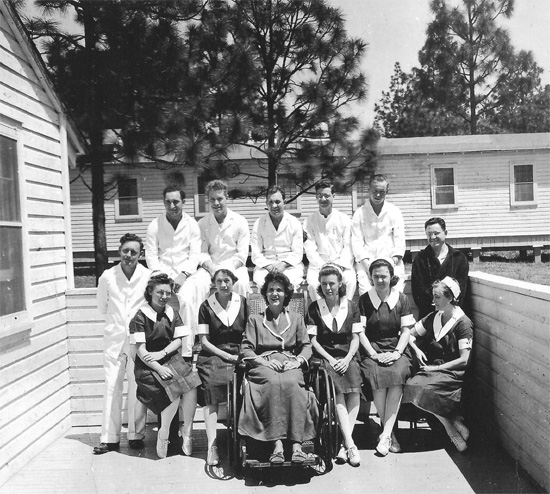
1943 group photo of personnel pertaining to the Physical Therapy Department, Camp Livingston, Alexandria, Louisiana.
United Kingdom:
The buildings, of a Nissen and Quonset-type construction, were located on a hillside occupying part of a private estate. Most of the construction was complete upon arrival. The pitch mastic floors were finalized after the unit’s arrival. The task of readying the hospital for the reception of patients was begun immediately, followed by the assignment of personnel to the various sections. A master training program was submitted to Headquarters, XVII District, for approval, and training based upon weekly schedules was instituted. The conditioning of personnel and emergency measures were emphasized; frequent drills in the defense of the installations and of personnel against air and chemical agent attacks were held. The general training programs continued in addition to professional services. Mobile surgical teams were organized for local emergencies and to aid nearby installations in cases of catastrophe. General physical welfare was maintained by mass athletics in addition to organized PT programs.
As supplies became available the various wards were placed in readiness for operation. Some minor changes in arrangement and construction to meet needs and preferences were introduced. After a great amount of concentrated effort and diligent attention to the tasks at hand by all concerned, the 58th General Hospital was ready to function, and was officially activated in the United Kingdom 3 December 1943 with a bed capacity of 1,084.
The first admissions on 4 December to the newly-activated medical facility were from the own command. The very first patient to come in was the unit’s own Chaplain; First Lieutenant Richard D. Johnson, suffering from a cold. Other patients received were transfers from a nearby Station Hospital which took place on 14 December 1943.
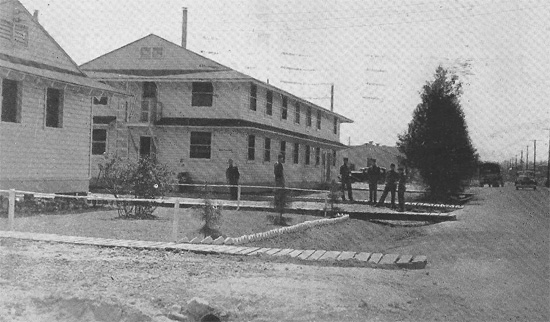
Partial view illustrating wooden cantonments at Fort Eustis, Lee Hall, Virginia where 29 ANC Officers were recruited in July 1943 to eventually join the new 58th General Hospital at Camp Livingston, Louisiana.
Mess and housing situations in the location were entirely satisfactory although it was felt that an allowance of only 65 mess personnel was inadequate (75 were deemed necessary). The distribution of food from the point of preparation to the widely dispersed wards required the utilization of a large number of people, as it had to be accomplished quickly in order to keep it hot when provided to the patients.
The water supply for the installation came from a small stream, the Cola River, running through the valley several miles beyond the limits of the unit’s installations, through farm and pasture land. The plant’s capacity was 7,000 gallons per hour, adequately supplying water for 1,600 to 2,000 persons (there were a few shortages in summer). The Post had its own sewage disposal plant and dry waste was burned in an incinerator built by the organization. The local geology created a mud problem with soil being continuously moist and some necessary paving was built to try and remedy the situation. No insect problems were encountered, and consequently no special control measures were needed.
All buildings were heated by small coal stoves, as they were largely exposed to the prevailing north winds. Keeping quarters warm and the stoves going created a problem in the conservation of both fuel and manpower.
Recreation was in the professional hands of the Special Service Officer and staff and by the ARC personnel assigned to the unit. Shows were given, movies were shown twice weekly, and a bus service was established to transport personnel to the nearest town, some fifteen miles distant. A new band, organized among the Enlisted personnel played for the numerous dances and partiers. Through the efforts of the American Red Cross personnel the wards were decorated in a fitting and attractive manner for the Christmas season. Carol singing was conducted for duty and patient personnel. Voluntary contributions of candy and sweets rations by the Officers and Nurses provided an enjoyable Xmas party for 50 British children living in the surrounding area.
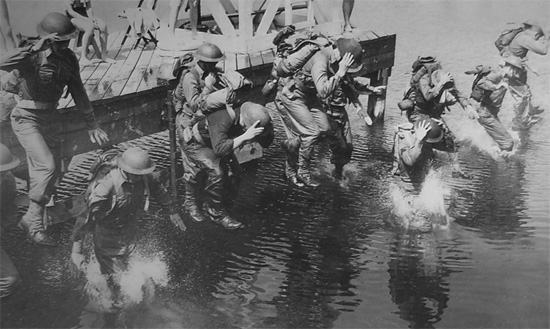
Zone of Interior 1942. Photos illustrating Swimming Training of Enlisted personnel at Fort Devens, Ayer, Massachusetts. The exercise involved jumping into the water and swimming a certain distance with full gear.
Early in December 1943, personnel (enough to run a 250-bed station hospital) were detailed to Wheatley, England, to help prepare a Station Hospital for operation. Later in the month, a small group of Officers, Nurses, and EM were called upon to prepare for occupancy by the US Army, the Royal Victoria Hospital at Netley, near Southampton, England. For their own use, a 15-acre vegetable garden was prepared under the supervision of a Dental Officer who possessed a good knowledge of agriculture. The presence of rodents in the area was dealt with in cooperation with local British authorities. Under the supervision of the unit Sanitary Officer, baited traps were placed for the elimination of mice, and any openings in the buildings properly sealed. Poisoned food was used for the extermination of rats.
As there were no laboratory specimen bottles, the problem was addressed and solved by applying to the Women’s Volunteer Society in a nearby town. The ladies responded with a generous supply of jam and preserve bottles which adequately met the need.
While at Stowell Park, the organization functioned as a true General Hospital. Patients were received and evacuated by air, rail, or by ambulance. Reception and evacuation varied from individual to mass movements. From the semi-rugged conditions on the site on arrival the unit produced many lasting changes and improvements, correcting structural defects, and introducing many minor and major alterations and additions to the location. Careful landscaping and planting changed the Post from an austere and forbidding aspect to a place of neatness and beauty.
It was with regret that the 58th left Stowell Park, England, for each member had contributed materially in making the institution smoothly functional, livable, and attractive.
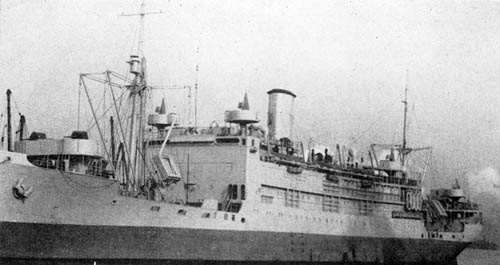
Photo illustrating USAT “Monterey” the transport vessel which took the 58th General Hospital across the Atlantic for service in the European Theater. Initial destination; the United Kingdom.
By process of infiltration the staff of the 160th General Hospital gradually took over the professional duties and the living quarters. The Nursing staff was sent in increments to the 203d General Hospital, then stationed at Burford, England, for additional training while the Enlisted Men and male Officers were moved by rail to Shipton Bellinger, England. Before leaving Stowell Park, all unit equipment was packed and shipped for the English Channel crossing. The vehicles were taken with the organization. The unit was to be attached to the Advance Section, Communications Zone, APO 513 (aka ADSEC, ComZ –ed).
The move took place on 12 May 1944, and after arriving at Shipton Bellinger (village some 12 mi NE of Salisbury –ed) surrounded by Salisbury Plain, the organization was to live for the first time under tentage. The gradual toughening-up process proceeded apace. The personnel had to adapt to living conditions under canvas, outdoor latrines, and the convenience of individual mess kits (though Nissen hut dining halls were used).
Training now included classes in the French language in addition to the standard military subjects. The nearness of artillery, machine gun, and rifle ranges, used by other units, acclimated the organization to combat conditions to be met later. The Nurses re-joined the 58th on 21 July 1944, and received further training at the camp. To acquire more experience, about 40% of the personnel were sent on DS to other units. These duties included work in the marshaling areas, feeding and servicing troops prior to the Invasion, actual triage of air and LST- evacuated casualties, and 1 Surgeon and 2 Surgical Technicians were attached to an LST (H) during the invasion and post D-Day trips for the treatment of wounded. After D-Day the various detached personnel returned to the organization and training continued, with hikes, close and extended order drill and group and supervised athletics. During the same period, recreation was not entirely overlooked; 24-hour passes were issued, trips to concerts and plays offered, camp movies shown, and several USO shows invited.
On 27 July 1944 the long anticipated move to the marshaling area was started, bed rolls, packs, and barrack bags were completed and the 58th entrained for Southampton (port extensively used in preparation for the Invasion of Europe, huge marshaling area in southern Hampshire extending as far as Winchester, numerous camps set up for troops and equipment in sub-areas W, X, Y, and Z, US reinforcements arrived there including many Lend-Lease imports, sections of Mulberry harbor constructed on site, after D-Day worked at full capacity to resupply Allied forces on the continent –ed). The camp was only a short march from the rail station. After arrival men and women were separated. The new area introduced the unit to shelter trenches near the tents. Shower facilities were distant, yet available. Outdoor ablution rooms were also accessible. C-rations were served for meals. Movies were shown at night. All personnel carried on with light duties.
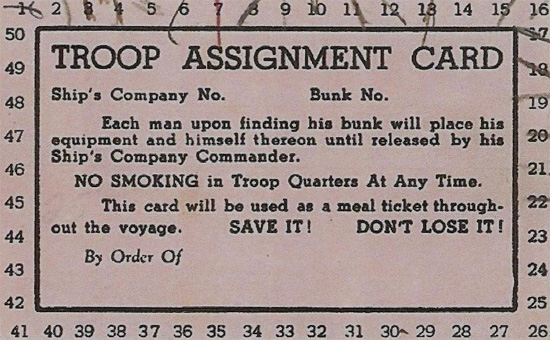
Illustration of a typical Troop Assignment Card as used on troop transports during overseas voyages. These cards were essential and not only carried the soldier’s bunk number but entitled him to the necessary (2) meals while traveling aboard the ship.
At noon 29 July 1944, orders were received to depart from the area and everyone proceeded afoot to the docks, approximately six miles away. Duffel bags and other packs were transported. After a short wait at the docks, all male personnel boarded the “Llangibby Castle” (former passenger liner built Nov 29, requisitioned as troop transport Jul 40, participated in Operation Torch 9 Nov 42, ferried troops in the Mediterranean, landed first wave of Canadian troops in Normandy 6 Jun 44, brought US troops to Omaha and Utah Beaches, and shuttled to Le Havre, France, made over 70 Channel crossings carrying over 100,000 troops –ed) joining the Nurses who had already boarded. There were other hospital units on the same ship.
United Kingdom Stations – 58th General Hospital
Stowell Park, Gloucestershire, England >1 January 1944 – 12 May 1944
Shipton Bellinger, Hampshire, England > 12 May 1944 – 27 July 1944
Marshalling Area, Camp C-12, Southampton, Hampshire, England > 27 July 1944 – 29 July 1944
France:
The ship weighed anchor promptly and the 58th was enroute to France, the date was 29 July 1944. The sea was calm and the crossing uneventful. The Nurses slept in staterooms, 2 on bunks and 1 on the floor, while male personnel slept in hammocks. Meals were tasty but not plentiful. Abandon ship drills and other exercises were held so that everyone knew his proper position in case of emergency. Religious services were held while crossing the Channel.
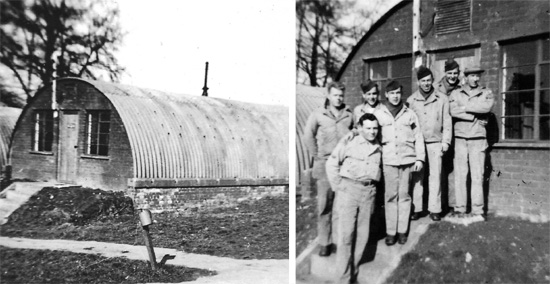
Enlisted personnel during their stay in the United Kingdom. Left: partial view illustrating Hut No. 24 at Stowell Park, Gloucestershire, England first home of the 58th General Hospital in the United Kingdom from January 1, 1944 to May 12, 1944. Right: group of Enlisted personnel of the 58th General Hospital in front of one of their hutments at Stowell Park.
The sighting of Cherbourg was welcomed and after reaching this point the ship proceeded along the coast to Utah Beach. Once arrived, the ship dropped and unloaded in an orderly manner all cargo and equipment into LCMs and all passengers and personal baggage onto a rhino barge for the short trip to shore. Male personnel hiked 8 miles to Transit Area B for an overnight bivouac in individual pup tents while the Nurses were trucked to another Transit Area, from where they continued on to Osmanville (slightly NE of Isigny-sur-Mer, in the Calvados –ed), France, spending the night at the 7th Field Hospital in squad tents. The men were picked up by motor convoy and joined the Nurses at the 7th Fld Hosp the following day. The same night surgical and shock teams were set up and already sent out to help support Evacuation and Field Hospitals assigned to the First United States Army. Two days later, the organization moved to Bolleville, France, near La Haye-du-Puits.
The presence of much aerial activity, antiaircraft guns, falling shrapnel, visual flares, and audible bombing and strafing were met with complacency due to thorough preliminary training. The teams which served with numerous Evacuation Hospitals learned how to be equally mobile at short notice. At Bolleville, Officers and Nurses were quartered in pyramidal tents and the EM in pup tents. Squad tents were only pitched on an elevation later, conveniently replacing the pup tents.

Enlisted personnel and Noncommissioned Officers pertaining to the 58th General Hospital visit he “ARC Tidworth House Club” during the organization’s stay at Shipton Bellinger, where they remained from May 12, 1944 until July 27, 1944.From L to R: Technician 5th Grade Benny Golden, Staff Sergeant Jack Sporn (34400327), and Staff Sergeant Henry A. Ross.
When all teams returned from DS in the latter part of August, the Engineers had prepared the hospital site, laying concrete platforms for the tents, connecting water pipes and electric lines. An order was then received for the 58th General to turn over all its equipment, which had arrived intact from England, to the 30th General Hospital. This was accomplished at once. By 8 September one quarter of the hospital was ready to receive patients, when suddenly orders arrived to cease operations and prepare for movement. The equipment was packed up on 21 September 1944 and an advance party departed while most of the personnel was loaded on a Hospital Train. Supplies and the remainder of the staff then crossed France by truck. The trip across a large part of France in a Hospital Train was an experience long to be remembered. Sleeping on litters in tiers of three offered certain conveniences, but the latrine and toilet facilities were rather limited. Only K-rations were eaten as no hot meals could be provided during traveling.
The Hospital Train arrived at Toul (medical air evac holding site –ed), France on 25 September 1944 and upon arrival the unit was conveyed by truck to a new camp site where pyramid tents had been erected by the advance party. Frequent rains, cold, and omnipresent mud caused a lot of discomfort while at Toul. Tent stoves were fortunately issued which provided considerable improvement. During the organization’s stay, a large group of Medical Officers were sent on DS daily to the 94th Medical Gas Treatment Battalion acting as an air evacuation holding unit, stationed only two miles away.
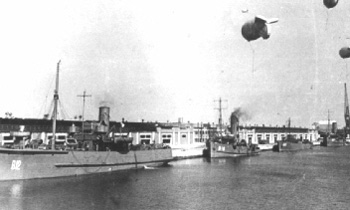
Illustration showing a partial view of the Western Docks, Southampton, England. The port facilities were protected by antiaircraft artillery and barrage balloons.
Early October another change of station took place. On 6 October 1944, the first elements of the unit entrucked for Commercy, France, and for the first time in five months were housed in buildings. Enlisted Men were located in the Caserne “Quartier Marguerite”, the male Officers in the “Hôpital St. Charles”, and the Nurses set up in the “Ecole Supérieure de Jeunes Filles”. The Enlisted Men’s mess was in the Caserne and the one destined for the Officers at the High School for Young Girls. After a seventeen-day period new instructions were received to proceed to the “Caserne Gérard” at Lérouville (NW of Commercy –ed), France, and prepare to set up the hospital. Personnel and staff moved in increments to the new site, starting 23 October 1944. The building had been occupied at various times by the French Army, the German Army, again by the French Army, and later by a US Army Ordnance Company. Frequent occupations without neither repairs nor renovations necessitated considerable work to provide convenient quarters and functional hospital buildings. The first problem was to get rid of the mud, dig trenches, fill hollows, cut down high ground points, provide a hard surface for the command vehicles, install outside latrines, clean sewers, connect water, and install fixtures. Engineers (first a single Platoon, later an entire Company) rendered valuable assistance in the reclamation of the site which included replacing windows and doors, repairing the plumbing and installing electricity, and finally painting the buildings inside. The four large 2-story hospital buildings received top priority, including such urgent works like glazing – plumbing – and electric repairs.
Each hospital floor was subsequently divided into seven wards with a hall at one side and a central staircase. The four buildings were connected by covered ways which in turn were connected to the surgery. The latter consisted of four huge rooms each of which had 2 lights and 2 operating room tables per room which could readily be expanded to 4 or more. Autoclaves were supplied with steam by a diesel-generated cyclotherm, and hot water was available for scrubbing. An emergency generator and portable autoclaves were housed in an adjoining building. There were a total of sixteen long buildings in parallel rows of four (corresponding to the upright of a large “T”). The smaller buildings of the complex were divided in compartments or apartments and served to house all the clinics, the surgical and medical offices and other functions required for hospital activities, including the ARC room and the Chapel. Three long buildings served as medical wards, while others housed the Officers, the Nurses, and the Enlisted Men. The vehicles which were supplied in England were shipped across the Channel in another ship, but were retained serving the unit in each location and aided in moving supplies and equipment across France. Attached Laundry Platoons were in charge of hospital linen and supplies, while personal laundry was handled by contracted civilians. Approximately 100 French civilians worked on the Post. There were also 250 German PWs housed in a stockade who labored under the terms of the Geneva Convention, thus helping release Enlisted personnel from minor duties and permitting sufficient men to function for ward duty in spite of reduced T/O allowances.
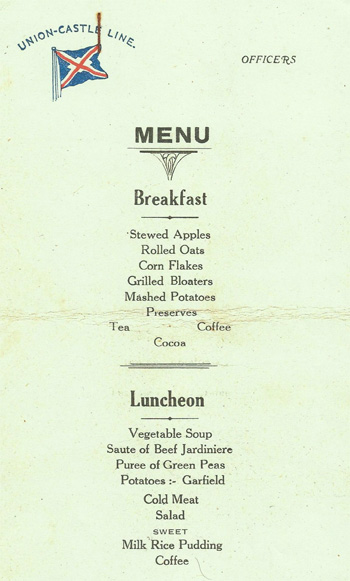
Officers’ Menu served on board the “Llangibby Castle” during the English Channel crossing July 29, 1944. The 58th General Hospital landed on Utah Beach, July 30, 1944.
The current installations of Hospital Plant # 4337 at Lérouville had a 1,300-bed capacity with possibilities of expansion to 1,500. Mass movements were received and evacuated, and although the 58th General was still operating as a holding unit, all necessary surgery was being performed by the organization itself, with an average of 77 patients received per day. It must be underlined that the skill of improvisation aided in facilitating every phase of the work as well as providing a modicum of comfort under adverse conditions. The organization would remain in Lérouville until after V-E Day.
V-E Day was thoroughly celebrated along with the civilians in Lérouville with a formal dress parade in town. During the first quarter of 1945, some promotions and changes in the staff were implemented, involving the arrival of a new Chief Nurse; Captain Ruth C. Baldwin, ANC, and the replacement of the current Chaplains by 2 new Officers; Chaplain Kausler (Protestant Faith) and Chaplain Kenny (Roman Catholic Faith).
Following new instructions received 9 July 1945, the 58th General moved to another site on 12 July to take over Hospital Plant # 4359 formerly operated by the 239th General Hospital at the “Hôpital Militaire”, situated at Châlons-sur-Marne, France, APO 513, which opened for operations and receipt of patients on 16 July 1945.

31 July 1944, Transit Area B, Utah Beach, Normandy. Hurting feet receive some treatment.
On 11 September 1945, when the 195th General Hospital formerly took over the hospital site and its patients, the personnel of the 58th was subjected to many changes. Before any orders had been received alerting the unit, all of the high-point Officers were transferred for immediate movement to the Zone of Interior via the “Green Project”. Shortly thereafter the Enlisted Men who had an ASR of 60 or less points were transferred out and high-pointers (70 and up) were transferred in. The only people remaining were the Nurses, the MAC Officers, and certain high-point EM. The 195th General effectively opened to receive patients as of 0001 hours, 12 September 1945.
The following replacements and transfers took place.
Major George A. Young , Jr., MC, O-1700582, from Headquarters & Headquarters Detachment, 813th Hospital Center was assigned to the 58th Gen Hosp for duty on 11 September 1945, as per VOCG, Oise Intermediate Section, Letter issued by Headquarters, Communications Zone, dated 17 July 1945.
Lieutenant Colonel Herman G. Janssen, Jr., DC, O-319236, and Captain Frank D. Dietrich, DC, O-308974, both from the 189th General Hospital, were assigned to the 58th Gen Hosp for duty on 11 September 1945, as per VOCG, Oise Intermediate Section, Letter issued by Headquarters, Communications Zone, dated 10 September 1945.
Lieutenant Colonel Clarence F. Johnston, MC, O-402335, from the 178th General Hospital, was assigned to the 58th Gen Hosp for duty on 11 September 1945, VOCG, Oise Intermediate Section, Letter issued by Headquarters, Communications Zone, dated 10 September 1945.
Captain Charles M. Oxley, MC, O-1693292, from the 14th Field Hospital, was assigned to the 58th Gen Hosp for duty on 11 September 1945, VOCG, Oise Intermediate Section, Letter issued by Headquarters, Communications Zone, dated 10 September 1945.
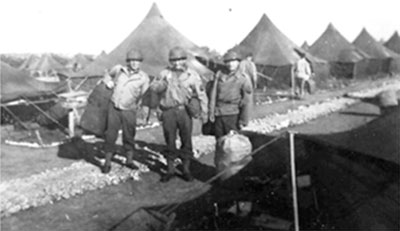
1944 Summer bivouac, France.
The next Officers, members of the 58th General Hospital, were released from assignment and duty and subsequently transferred to other medical organizations, effective 11 September 1945, as per VOCG, Oise Intermediate Section, Letter issued by Headquarters, Communications Zone, dated 10 September 1945:
Major Albert A. Piersdale, MC, O-357976, transferred to the 178th General Hospital.
Major Conrad Spilka, DC, O-486996, transferred to the 189th General Hospital.
Captain William R. Craig, MC, O-427811, transferred to the 28th Field Hospital.
Captain Ernest W. Denicke, MC, O-498701, transferred to the 74th General Hospital.
Captain Ralph P. Elrod, SnC, O-483386, transferred to the 178th General Hospital.
Captain Frank Goldstein, MC, O-478550, transferred to the 28th General Hospital.
Captain Clarence A. Lion, MC, O-500268, transferred to the 189th General Hospital.
Captain Carl F. Meschke, MAC, O-1545109, transferred to the 93d Medical Gas Treatment Battalion.
Captain Pasquale Montilli, MC, O-1689570, transferred to the 189th General Hospital.
Captain William S. Scott, MC, O-356547, transferred to the 81st General Hospital.
First Lieutenant John E. Closson, CoE, O-360597, transferred to the 62d General Hospital.
First Lieutenant Elmer R. Wormus, SnC, O-522339, transferred to the 94th General Hospital.
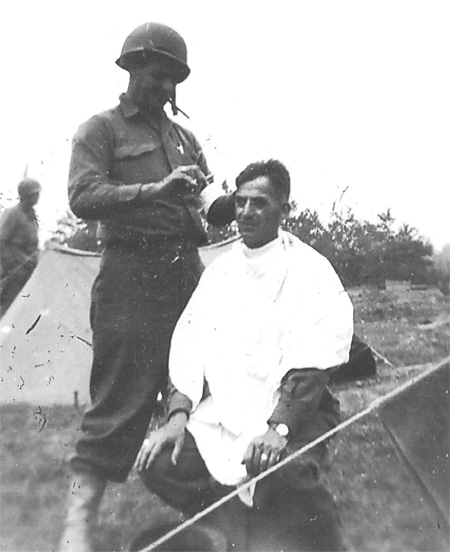
August 1944, Osmanville, Normandy. First haircut in France, or is it a shave? From L to R: Privates Mark L. Shepard and George Beyers.
The first readiness date was 20 September and guesses as to the actual date for Redeployment were the major topic of conversation. However the date passed without event and on that specific date the organization was alerted that 8 October 1945 was the new ‘readiness’ date! During the above period new personnel were assigned to bring the 58th back to its T/O strength. Meanwhile the MAC Officers running the Headquarters administration were busy, night and day, preparing rosters, stencils, and bringing up to date all records pertaining to the Officers and Enlisted Men. On 17 October 1945, the unit was notified that on precisely the 21st of October it would move from Châlons-sur-Marne to the Calas Staging Area, near Marseille, Southern France. On 18 October, another 195 EM with less than 80 points were transferred; this was a severe blow to morale, because at this time all processing had been completed and the 58th General Hospital was ready to move. Since the orders couldn’t be changed, the personnel section had to start the paperwork all over again! It was somehow done in the few remaining days and when the new men joined the organization, everybody was glad and ready to entrain at the date and time specified.
France Stations – 58th General Hospital
Transit Area B, Utah Beach, France: 30 July 1944 – 31 July 1944
Osmanville, France: 31 July 1944 – 2 August 1944
Bolleville, France: 2 August 1944 – 21 September 1944
Toul, France: 25 September 1944 – 6 October 1944
Commercy, France: 6 October 1944 – 22 October 1944
Lérouville, France: 23 October 1944 – 12 July 1945
Châlons-sur-Marne: 16 July 1945 – 21 October 1945
Calas, Southern: France 23 October 1945 – 31 October 1945
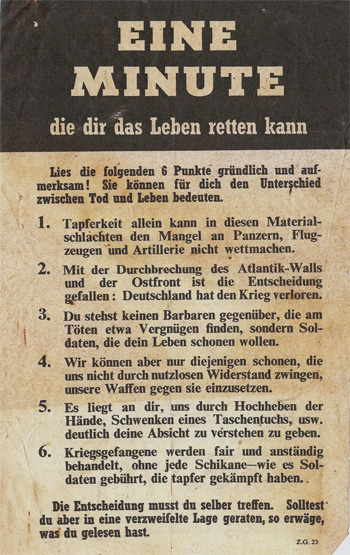
Sample of Allied Psywar Leaflet ZG.23 picked up by Technician 5th Grade Charles D. Bossart (13107471) in Normandy. Produced by PWD/SHAEF, these leaflets were dropped over Normandy by Allied aircraft beween July 12, 1944 and August 20, 1944.
The Officers and Enlisted Men arrived at the Calas Staging Area on 23 October and were assigned to a tented area in order to await further orders. The Nurses had not accompanied the group and were directed to another staging area. Information was later received that the Nurses would not rejoin the organization but would move directly to Le Havre, northern France, for embarkation.
On Sunday, 28 October orders were received that all personnel of the 58th General Hospital would load on the Liberty Ship S/S “Felix M. Grundy” (launched 12 May 43, very active in the Mediterranean Theater from Nov 42 until Mar 45 –ed) on or about 30 October 1945 for movement to the United States. For once, the rumor became a hard fact and the unit indeed boarded on 31 October 1945. The ship then weighed anchor at 1730 hours the same day, and the organization started on its homeward journey…
The following incomplete passenger list includes a group of Officers pertaining to the 58th Gen Hosp (unit serial no. RE 7305-F). After staging at Calas, Southern France, instructions were received to board the “Felix M. Grundy” for return to the ZI.
Colonel George B. Best, MC, O-229114 (ASR 69 points)
Lt. Colonel Herman G. Janssen, Jr., DC, O-319236 (ASR 93 points)
Major Walter L. Badger, DC, O-275090 (ASR 92 points)
Major Jack R. Cory, MAC, O-1533286 (ASR 92 points)
Major Norman G. Hickey, MC, O-485545 (ASR 86 points)
Major Max S. Kaesche, MAC, O-473361 (ASR 90 points)
Major Samuel A. Leishear, DC, O-340921 (ASR 66 points)
Major Myron A. Schrantz, DC, O-409076 (ASR 95 points)
Major Chester A. Taylor, ChC, O-260611 5ASR 100 points)
Major Milton S. Travin, DC, O-362336 (ASR 85 points)
Captain Robert J. Arendt, DC, O-485599 (ASR 101 points)
Captain William H. Bafer, MAC, O-1533486 (ASR 119 points)
Captain Glenn H. Bailey, MAC, O-1546657 (ASR 89 points)
Captain Robert G. Cameron, Jr., FA, O-365278 (ASR 91 points)
Captain Donald M. Cobb, ChC, O-282936 (ASR 107 points)
Captain Frank D. Dietrich, DC, O-308974 (ASR 89 points)
Captain Melvin A. Dobbs, SnC, O-515992 (ASR 65 points)
Captain Arthur W. Harvey, MAC, O-502683 (ASR 69 points)
Captain Arthur S. Hedlund, MAC, O-1546737 (ASR 88 points)
Captain Harold D. Hirsch, FA, O-436680 (ASR 92 points)
Captain Frederick A. Holliday, MAC, O-420760 (ASR 87 points)
Captain Robert L. Hughes Jr., MAC, O-461611 (ASR 87 points)
Captain Maxwell Lewis, DC, O-497119 (ASR 90 points)
Captain Claude D. Owens, DC, O-527406 (ASR 86 points)
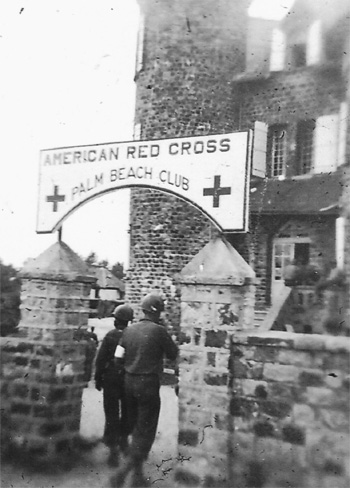
While traveling through the Cotentin Peninsula, personnel of the 58th General Hospital take some time to visit the “ARC Palm Beach Club” at Barneville, on the west coast of the Peninsula.
Officers Roster – 58th General Hospital (31 December 1943)
Administration
Colonel Harold B. Luscombe, MC, O-18298 > Commanding Officer
Major Alvin J. Swingle, MC, O-449910 > Executive Officer
Captain John I. Spreckelmyer, MAC, O-194062 > Adjutant
————
Captain Arthur W. Harvey, MAC, O-502583 > Medical Supply Officer
Captain Bastian C. Verschoor, MAC, O-512346 > Mess Officer
Captain Maurice H. Born, QMC, O-1575772 > Supply Officer
Captain Newlin W. Floyd, MAC, O-1542501 > Detachment Commander
Captain William J. Snyder, MC, O-329161 > Admission & Disposition Officer
Captain Richard D. Johnson, ChC, O-487819 > Protestant Chaplain
Captain Walter H. Smith, ChC, O-492579 > Catholic Chaplain
First Lieutenant John R. Burrows, MAC, O-508884 > Registrar
Second Lieutenant Daniel J. Lynch, Jr., MAC, O-1534547 > Personnel Officer
Second Lieutenant Millard F. Beyer, MAC, O-244240 > Asst. Registrar
Second Lieutenant Mortimer H. Kuehn, QMC, O-1578730 > Asst. Supply Officer
Second Lieutenant Harold E. Laak, MAC, O-1542521 > Asst. Detachment Commander
Warrant Officer (JG) Peter C. Adamkiewicz, USA, W-2105632 > Chief Clerk and Asst. Adjutant

August 1944, traveling in Normandy. Enlisted personnel of the 58th General Hospital enjoy a short break while traveling by train from Barneville, Cotentin Peninsula to Avranches, Normandy.
Professional Services
Lt. Colonel Frank R. Bailey, MC, O-410134 > Chief of Surgical Service
Lt. Colonel James M. Strang, MC, O-409137 > Chief of Medical Service
Major Hyman A. Slesinger, MC, O-225896 > Chief of Laboratory Service
Major James B. Hall, MC, O-438407 > Chief of X-Ray Service
Captain Paul E. Gardner, DC, O-407425 > Chief of Dental Service
Captain Agnes M. Patterson, ANC, N-743661 > Chief Nurse
First Lieutenant Margaret B. Borland, ANC, N-759829 > Asst. Chief Nurse
First Lieutenant Elise E. Meyer, ANC, N-725390 > Asst. Chief Nurse
Second Lieutenant Marguerite Sillery, PTA, M-718 > Physiotherapy Aide
Second Lieutenant Alvina R. Beran, HD, R-317 > Hospital Dietitian
Second Lieutenant Pearl Tyner, HD, R-837 > Hospital Dietitian
Surgical Service
Major Thomas G. Ferguson, MC, O-410363 > Ward Officer
Major Elmer S. A. King, MC, O-251840 > Ward Officer
Major David W. Morgan, MC, O-276324 > Ward Officer
Major Stuart N. Rowe, MC, O-409894 > Ward Officer
Major Joseph A. Soffel, MC, O-410441 > Ward Officer
Major Walter W. Woodhouse, MC, O-411665 > Ward Officer
Captain Delmas L. Cribbs, MC, O-478073 > Ward Officer
Captain William L. Hauk, MC, O-409826 > Ward Officer
Captain Alfred F. Knoll, MC, O-356907 > Ward Officer
Captain Andrew J. McAdams, MC, O-327611 > Ward Officer
Captain Charles C. Murphy, MC, O-410356 > Ward Officer
Captain Theodore W. Redman, MC, O-225888 > Ward Officer
Captain Harold H. Sankey, MC, O-436729 > Ward Officer
Captain James N. Stanton, Jr., MC, O-409136 > Ward Officer
First Lieutenant Ralph S. Blasiole, MC, O-436217 > Ward Officer
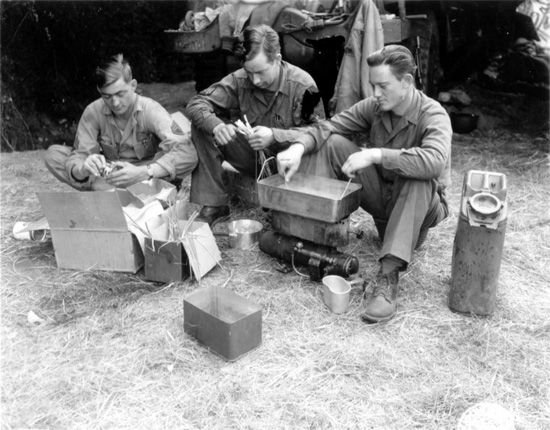
August 1944. Traveling in Normandy. Short bivouac enjoyed by members of the 58th General Hospital.
Medical Service
Major George E. Bair, MC, O-173875 > Ward Officer
Major John W. Harmeier, MC, O-251835 > Ward Officer
Majoir William A. Heazlett, MC, O-251836 > Ward Officer
Major Thomas W. Martin, MC, O-252447 > Ward Officer
Major Thomas C. McKee, MC, O-420767 > Ward Officer
Major Carl L. Ruder, MC, O-439069 > Ward Officer
Captain Harry A. Black, Jr., MC, O-368806 > Ward Officer
Captain Eugene M. Hagan, MC, O-358586 > Ward Officer
Captain Frank T. Herron, MC, O-307555 > Ward Officer
Captain Charles C. Huston, MC, O-409825 > Ward Officer
Captain Samuel R. Perrin, MC, O-410702 > Ward Officer
Captain John J. Stubbs, MC, O-345421 > Ward Officer
First Lieutenant Thomas R. Purpura, MC, O-436218 > Ward Officer
First Lieutenant Knighten V. B. Waite, MC, O-448196 > Ward Officer
Laboratory Service
Captain Ralph P. Elrod, SnC, O-483386 > Laboratory Officer
Captain Elmer R. Wormus, SnC, O-522339 > Laboratory Officer
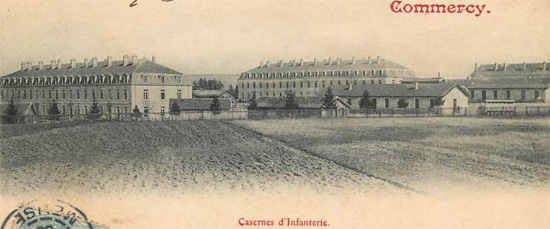
Vintage postcard illustrating the old French Army Infantry Barracks (part of the “Quartier Marguerite”) at Commercy, Lorraine where the Enlisted Men were quartered from October 6, 1944 to October 22, 1944.
X-Ray Service
Captain John F. Maurer, MC, O-269639 > Ward Officer
Dental Service
Captain Charles A. Harmeier, Jr., DC, O-407424 > Dental Officer
Captain Conrad Spilka, DC, O-486996 > Dental Officer
First Lieutenant John E. Campbell, DC, O-443565 > Dental Officer
First Lieutenant John J. Kifer, DC, O-443543 > Dental Officer
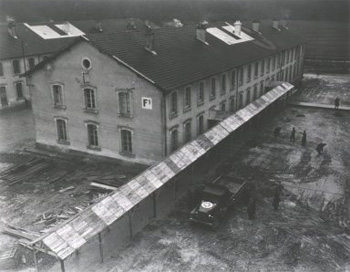
End October 1944. Partial view of the installations (“Caserne Gérard”) at Lérouville, Lorraine. The site would house the 58th General Hospital from October 23, 1944 to 12 July 1945.
Nursing Service
Second Lieutenant Teresa M. Aigner, ANC, N-759154 > Ward Nurse
Second Lieutenant Mary B. Allen, ANC, N-741006 > Ward Nurse
Second Lieutenant Thelma L. Anstead, ANC, N-759155 > Ward Nurse
Second Lieutenant Loretta E. Applegate, ANC, N-759757 > Ward Nurse
Second Lieutenant June E. Barth, ANC, N-759211 > Ward Nurse
Second Lieutenant Frances M. Bedwell, ANC, N-759186 > Ward Nurse
Second Lieutenant Mary E. Beichner, ANC, N-759295 > Ward Nurse
Second Lieutenant Jeannette M. Bodis, ANC, N-759893 > Ward Nurse
Second Lieutenant Cornelia A. Boney, ANC, N-725392 > Ward Nurse
Second Lieutenant Eloise B. Brinkworth, ANC, N-759828 > Ward Nurse
Second Lieutenant Elizabeth S. Cadman, ANC, N-744437 > Ward Nurse
Second Lieutenant Mildred K. Caldwell, ANC, N-759296 > Ward Nurse
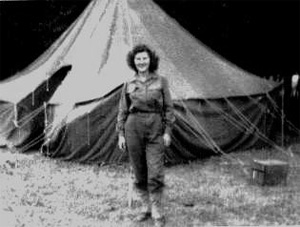
Portrait of Second Lieutenant Ruth W. Haddick (N-759351) in front of a pyramid tent somewhere in France. Lieutenant Haddick was a member of the Army Nurse Corps assigned to the 58th General Hospital.
Second Lieutenant Mary C. Campbell, ANC, N-759156 > Ward Nurse
Second Lieutenant Mary V. Campbell, ANC, N-759398 > Ward Nurse
Second Lieutenant Jennie L. Caparoso, ANC, N-759758 > Ward Nurse
Second Lieutenant Mildred O. Conin, ANC, N-744174 > Ward Nurse
Second Lieutenant Kathleen I. Derstine, ANC, N-760010 > Ward Nurse
Second Lieutenant Vivian W. Doub, ANC, N-759583 > Ward Nurse
Second Lieutenant Pauline R. Douds, ANC, N-759297 > Ward Nurse
Second Lieutenant Hazel B. Dove, ANC, N-759796 > Ward Nurse
Second Lieutenant Kathrine M. Duralia, ANC, N-759157 > Ward Nurse
Second Lieutenant Martha M. Erkkila, ANC, N-759158 > Ward Nurse
Second Lieutenant Anna R. Fisher, ANC, N-759160 > Ward Nurse
Second Lieutenant Martha J. Fox, ANC, N-759630 > Ward Nurse
Second Lieutenant Mildred N. Furlong, ANC, N-759162 > Ward Nurse
Second Lieutenant Rose A. Gadosy, ANC, N-759759 > Ward Nurse
Second Lieutenant Artie M. Garrett, ANC, N-745047 > Ward Nurse
Second Lieutenant Mary A. Gaughan, ANC, N-744438 > Ward Nurse
Second Lieutenant Doris K. Gleim, ANC, N-759350 > Ward Nurse
Second Lieutenant Agnes C. Glunt, ANC, N-759163 > Ward Nurse
Second Lieutenant Marian L. Gosser, ANC, N-759164 > Ward Nurse
Second Lieutenant Sara M. Greenfield, ANC, N-744551 > Ward Nurse
Second Lieutenant Mary E. Gulas, ANC, N-744439 > Ward Nurse
Second Lieutenant Ester H. Guthridge, ANC, N-744440 > Ward Nurse
Second Lieutenant Ruth W. Haddick, ANC, N-759351 > Ward Nurse
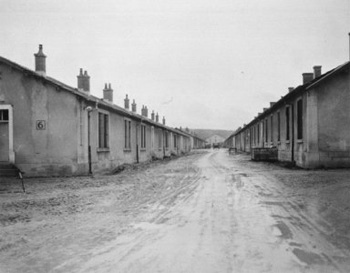
Fall of 1944. Partial view of Enlisted Men’s barracks at Lérouville, Lorraine, France. The 58th General Hospital officially celebrated VE-Day while stationed in Lérouville.
Second Lieutenant Mary H. Haines, ANC, N-760635 > Ward Nurse
Second Lieutenant Hester S. Halderman, ANC, N-759563 > Ward Nurse
Second Lieutenant Mary D. Hartman, ANC, N-759760 > Ward Nurse
Second Lieutenant Dorothy L. Hileman, ANC, N-759165 > Ward Nurse
Second Lieutenant Mary M. Hunt, ANC, N-744441 > Ward Nurse
Second Lieutenant Edith S. Jack, ANC, N-759166 > Ward Nurse
Second Lieutenant Clara E. Jacob, ANC, N-729035 > Ward Nurse
Second Lieutenant Laura E. Johns, ANC, N-759167 > Ward Nurse
Second Lieutenant Geraldine Jones, ANC, N-759740 > Ward Nurse
Second Lieutenant Mary M. Kennedy, ANC, N-759169 > Ward Nurse
Second Lieutenant Thelma J. Kinney, ANC, N-744058 > Ward Nurse
Second Lieutenant Esther V. Klee, ANC, N-759170 > Ward Nurse
Second Lieutenant Marie Kohler, ANC, N-760012 > Ward Nurse
Second Lieutenant Anna H. Lilley, ANC, N-759840 > Ward Nurse
Second Lieutenant Catherine F. Logue, ANC, N-759564 > Ward Nurse
Second Lieutenant Elvi I. Matta , ANC, N-759565 > Ward Nurse
Second Lieutenant Mary C. Marshall, ANC, N-744780 > Ward Nurse
Second Lieutenant Kathryn A. Matkowski, ANC, N-759193 > Ward Nurse
Second Lieutenant Mercedes A. McCort, ANC, N-759212 > Ward Nurse
Second Lieutenant Mildred D. McNeill, ANC, N-760443 > Ward Nurse
Second Lieutenant Essa L. Michel, ANC, N-744170 > Ward Nurse
Second Lieutenant Sue L. Michlo, ANC, N-763042 > Ward Nurse

Fall of 1945. Official gate to the Calas Staging Area in Southern France where the 58th General Hospital staged from October 23, 1945 to October 31, 1945, while preparing its return to the Zone of Interior.
Second Lieutenant Anna F. Milton, ANC, N-759172 > Ward Nurse
Second Lieutenant Marie A. Miller, ANC, N-759399 > Ward Nurse
Second Lieutenant Mary H. Mitsch, ANC, N-724714 > Ward Nurse
Second Lieutenant Frances E. Morrow, ANC, N-759175 > Ward Nurse
Second Lieutenant Katherine R. Norwood , ANC, N-744444 > Ward Nurse
Second Lieutenant Virginia M. O’Donnell, ANC, N-759174 > Ward Nurse
Second Lieutenant Anna B. Pacek, ANC, N-760038 > Ward Nurse
Second Lieutenant Mary G. Quigley, ANC, N-744782 > Ward Nurse
Second Lieutenant Thelma L. Raphael, ANC, N-721255 > Ward Nurse
Second Lieutenant Martha V. Repp, ANC, N-759821 > Ward Nurse
Second Lieutenant Freda Rice, ANC, N-724307 > Ward Nurse
Second Lieutenant Julia M. Ring, ANC, N-744783 > Ward Nurse
Second Lieutenant Caroline C. Riva, ANC, N-744784 > Ward Nurse
Second Lieutenant Dorothy E. Ryan, ANC, N-744446 > Ward Nurse
Second Lieutenant Julia R. Sache, ANC, N-759568 > Ward Nurse
Second Lieutenant Rebecca Sack, ANC, N-759298 > Ward Nurse
Second Lieutenant Margaretta Salata, ANC, N-726374 > Ward Nurse
Second Lieutenant Agnes A. Salopek, ANC, N-759631 > Ward Nurse
Second Lieutenant Hildegarde E. Schultz, ANC, N-759175 > Ward Nurse
Second Lieutenant Elizabeth M. Seelhorst, ANC, N-759401 > Ward Nurse
Second Lieutenant Anna E. Shaffer, ANC, N-759176 > Ward Nurse
Second Lieutenant Geraldine A. Smith, ANC, N-759178 > Ward Nurse
Second Lieutenant Ruth A. Stepek, ANC, N-744447 > Ward Nurse
Second Lieutenant Mary K. Striebich, ANC, N-759180 > Ward Nurse
Second Lieutenant Alice C. Strobel, ANC, N-725744 > Ward Nurse
Second Lieutenant Helene I. Tadowski, ANC, N-759632 > Ward Nurse
Second Lieutenant Mabel H. Taglieber, ANC, N-760128 > Ward Nurse
Second Lieutenant Janet M. Turnbull, ANC, N-759822 > Ward Nurse
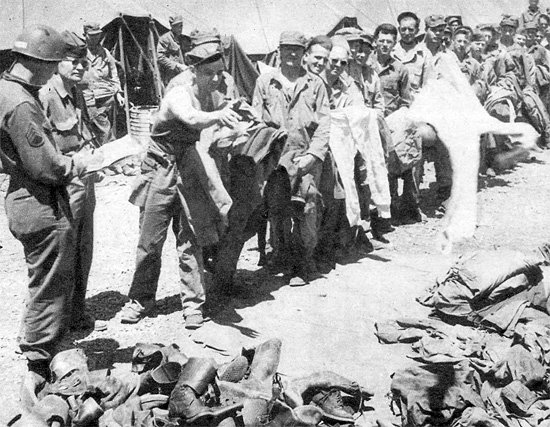
October 1945. Scene taken at the Calas Staging Area, Southern France. During staging and preparation for overseas movement (return to the ZI), Enlisted personnel are changing worn garments for clean clothes.
Second Lieutenant Francis H. Vukovich, ANC, N-759633 > Ward Nurse
Second Lieutenant Gladys F. Wagner, ANC, N-759299 > Ward Nurse
Second Lieutenant Mildred A. Wallace, ANC, N-759181 > Ward Nurse
Second Lieutenant Gladys M. Walter, ANC, N-760448 > Ward Nurse
Second Lieutenant Bernice V. Wasilewski, ANC, N-760373 > Ward Nurse
Second Lieutenant Helen M. Weakland, ANC, N-760586 > Ward Nurse
Second Lieutenant Beryl F. Weimer, ANC, N-744395 > Ward Nurse
Second Lieutenant Stephanie Wekluk, ANC, N-725280 > Ward Nurse
Second Lieutenant Stella M. Wenckunas, ANC, N-759883 > Ward Nurse
Second Lieutenant Helen G. Wissinger, ANC, N-759182 > Ward Nurse
Second Lieutenant Dorothy E. Woods, ANC, N-760341 > Ward Nurse
Second Lieutenant Angela M. Zarella, ANC, N-744449 > Ward Nurse
Enlisted Men’s Roster (incomplete)
Master Sergeant Thomas E. Herman, 36110952
Master Sergeant Bernard C. Sheehan
Technical Sergeant Sylvan E. Ehman, 13132592
Technical Sergeant Osiride A. DiSilvio, 13107202
Technical Sergeant John E. Hammersley, 36110770
Staff Sergeant Clifford A. Haynes, 33022707
Staff Sergeant Lloyd H. Nygaard, 17051300
Staff Sergeant Milbert Ray, 37249492
Staff Sergeant Henry Ross
Staff Sergeant Jack Sporn, 34400327
Technician 3d Grade Leo P. Albert, 20143485
Technician 3d Grade William D. Coombs, 13130786
Technician 3d Grade William F. Gavin, 13132487
Technician 3d Grade Joseph Miko, 13110952
Technician 3d Grade George W. Orth, 13088093
Sergeant Harry J. Bubenheim, 13089109
Sergeant Simon Schwartz, 13112636
Sergeant Thomas H. Whatley, 34169070
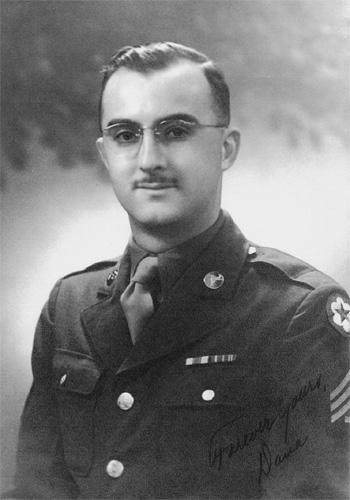
Portrait of Technician 4th Grade Charles Dana Bossart (13107471), member of the 58th General Hospital. Tec 4 Charles D. Bossart (member of the ERC) joined the 58th General Hospital August 17, 1942. On December 1, 1942 he was contacted and informed that he was likely to be ordered into active military duty the same month. On December 4, 1942, Pvt Bossart was informed that he was to report for active duty and temporay assignment to the 207th General Hospital.
Technician 4th Grade Charles D. Bossart, 13107471
Technician 4th Grade Stanley L. Cesak, 36339054
Technician 4th Grade Martin T. Dolan, 37046124
Technician 4th Grade Emil Haas, 36618420
Technician 4th Grade Joseph R. Julian, 13132721
Technician 4th Grade Franklyn M. Masters, 35478379
Technician 4th Grade Edward Mauerberger, 13132637
Technician 4th Grade Donovan W. Oldridge, 35364735
Technician 4th Grade Herbert N. Overby, 38106977
Technician 4th Grade Norman W. Pauly, 37200741
Technician 4th Grade Wilbur E. Phillips, 15101977
Technician 4th Grade Kenneth W. Rhoades, 35377571
Technician 4th Grade Earl J. Smith, 34319914
Technician 4th Grade Arthur M. Yoder, 35403608
Corporal Lonie D. Alford, 34382548
Corporal James D. Brown, 35481339
Corporal Robert J. Glines, 39527958
Corporal Edward R. Moore, 34319867
Technician 5th Grade James S. Blake, 35356495
Technician 5th Grade David Borer, 32501536
Technician 5th Grade Bernard Brickman, 32484211
Technician 5th Grade Niels Christensen, 13087280
Technician 5th Grade Jack E. Cuthbert, 39904905
Technician 5th Grade James H. Day, 38113107
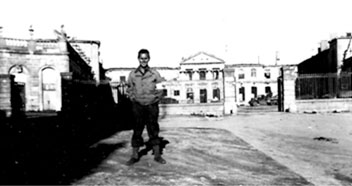
An unidentified member of the 58th photographed in front of the Château Stanislas in Commercy, France.
Technician 5th Grade Alciviredes T. Economos, 33369707
Technician 5th Grade Milburn M. Gilcrease, 38185193
Technician 5th Grade Benny Golden
Technician 5th Grade Kurt S. Greenbaum, 32512896
Technician 5th Grade Robert J. Hole, 39845066
Technician 5th Grade Robert J. Kellison, 37402476
Technician 5th Grade Michael Mazulla, 37230080
Technician 5th Grade John C. Michels, 33283345
Technician 5th Grade Samuel Nechin, 32684738
Technician 5th Grade Edward A. Plankers, 37543562
Technician 5th Grade David Peele, 35357305
Technician 5th Grade Wesley K. Salisbury, 36529154
Technician 5th Grade Edgar E. Sears, 38206477
Technician 5th Grade Robert D. Short, 13132687
Technician 5th Grade Holland C. Swallow, 37331236
Technician 5th Grade Quentin C. Unruh, 39848219
Private First Class Joe Brewer, 38399252
Private First Class Henry E. Brookshire, 37501067
Private First Class Philip C. Clark, 35531640
Private First Class Stuart L. Compton, 37505844
Private George M. Beyers
Private Hershel R. Cameron, 39408238
Private George M. Kelly, 1307090
Private Frank J. Lynn, 1261167
Private Hughie E. Rosner, 36444611
Private Mark L. Shepard
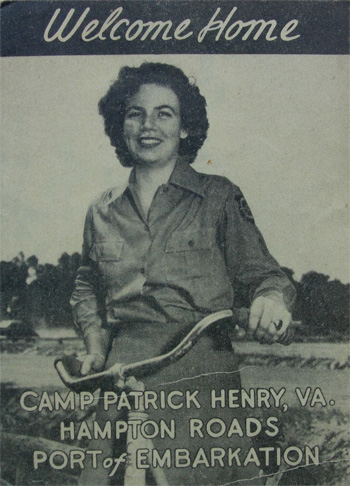
Camp Patrick Henry Booklet welcoming soldiers returning home to their loved ones. Embarkation and Debarkation Port in Virginia and Staging Area for Hampton Roads. Site where the 58th General Hospital was inactived November 16, 1945.
According to the “West-Word-Ho”, newsletter published on board the “Felix M. Grundy”, the Hospital group traveled from Châlons-sur-Marne, via Dijon, and Lyon, to the Calas Staging Area (near Marseille). The 58th Gen Hosp then boarded the Liberty Ship, leaving the Port of Marseille, Southern France on 31 October 1945 with destination the United States.
After returning to the Zone of Interior, the 58th General Hospital was officially deactivated at Camp Patrick Henry, Oriana, Virginia (Staging Area for Hampton Roads Port of Embarkation, total acreage 1,649, troop capacity 1,621 Officers and 22,916 EM –ed), on 16 November 1945.
Campaign Credits – 58th General Hospital
Northern France
Ardennes-Alsace
Our heartfelt thanks go to the late Lynn F. McNulty, our most generous contributor. Without his help and assistance, it wouldn’t have been possible to edit this concise Unit History of the 58th General Hospital. We furthermore very much appreciated the large number of vintage photos provided by Della Bossart, daughter-in-law of Technician 4th Grade Charles D. Bossart (ASN:13107471) who served with the Hospital in the ETO. The MRC Staff are still looking for a complete Enlisted Men’s Roster and welcome any additional data to the above
